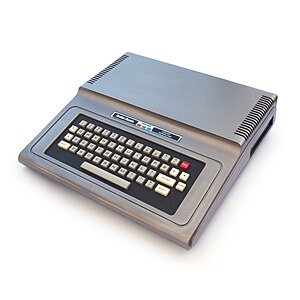Color Computer

16k TRS-80 Color Computer 1
|
|
| Developer | Tandy Corporation |
|---|---|
| Manufacturer | Motorola |
| Introductory price | US$399 (equivalent to $1,185 in 2017) |
| Discontinued | 1991 |
| Operating system | Color BASIC 1.0 / 2.0 / OS-9 |
| CPU | Motorola 6809E @ 0.895 MHz / 1.79 MHz |
| Memory | 4 kB / 16 kB / 32 kB / 64 kB / 128 kB / 512 kB |
| Graphics | MC6847 Video Display Generator (VDG) |
The RadioShack TRS-80 Color Computer (also marketed as the Tandy Color Computer and sometimes nicknamed the CoCo) is a line of home computers based on the Motorola 6809 processor. The Tandy Color Computer line started in 1980 with what is now called the CoCo 1 and ended in 1991 with the more powerful CoCo 3. All three CoCo models maintained a high level of software and hardware compatibility, with few programs written for the older model not running on the newer ones.
Despite bearing the TRS-80 name, the Color Computer is a radical departure from the earlier TRS-80; in particular it has a Motorola 6809E processor, rather than the TRS-80's Zilog Z80. The machines in the Color Computer line are not compatible with software made for the earlier TRS-80.
The TRS-80 Color Computer started out as a joint venture between Tandy Corporation of Fort Worth, Texas and Motorola Semiconductor, Inc. of Austin, to develop a low-cost home computer in 1977.
The initial goal of this project, called "Green Thumb," was to create a low cost Videotex terminal for farmers, ranchers, and others in the agricultural industry. This terminal would connect to a phone line and an ordinary color television and allow the user access to near-real-time information useful to their day-to-day operations on the farm.
Motorola's MC6847 Video Display Generator (VDG) chip was released about the same time as the joint venture started and it has been speculated that the VDG was actually designed for this project. At the core of the prototype "Green Thumb" terminal, the MC6847, along with the MC6809 microprocessor unit (MPU), made the prototype a reality by about 1978. Unfortunately, the prototype contained too many chips to be commercially viable. Motorola solved this problem by integrating all the functions of the many smaller chips into one chip, the MC6883 Synchronous Address Multiplexer (SAM). By that time in late 1979, the new and powerful Motorola MC6809 processor was released. The SAM, VDG, and 6809 were combined and the AgVision terminal was born.
...
Wikipedia
